[1]
WATTS D J, STROGATZ S H. Collective dynamics of small world networks[J]. Nature, 1998, 393: 440-442.
DOI: 10.1038/30918
Google Scholar
[2]
Barabási A L, ALBERT R. Emergence of scaling in random networks[J]. Science, 1999, 286: 509-512.
Google Scholar
[3]
ALBERT R, Barabási A L. Statistical mechanics of complex networks[J]. Rev of Modern Phys, 2002, 74: 47-97.
DOI: 10.1103/revmodphys.74.47
Google Scholar
[4]
Liang Zhao, et al. Onset of traffic congestion in complex networks[J]. Physical Review E, 2005, 71(2): 026125.
Google Scholar
[5]
Tadić B, Thurner S, Rodgers G J. Traffic on complex networks: Towards understanding global statistical properties from microscopic density fluctuations[J]. Physical Review E, 2004, 69(3): 036102.
DOI: 10.1103/physreve.69.036102
Google Scholar
[6]
Yaozhong Shi, Xuewu Chen. Technical Evaluation Indicator and Standard In Highway Network Planning[J]. CHINA JOURNAL OF HIGHWAY AND TRANSPORT, 1995, 8(1): 120-124. (In Chinese).
Google Scholar
[7]
Wuyang Yang, etc. Transportation Geography[M]. The commercial press, 1986(In Chinese).
Google Scholar
[8]
Jun Xu, Songling Luo. A study of connectness for the highway network[J]. CHINA JOURNAL OF HIGHWAY AND TRANSPORT, 2000(01): 95-97. (In Chinese).
Google Scholar
[9]
Wei Zhou, Shengrui Zhang, Hangshan Gao. A Study of the Comprehensive Evaluation for the Road Network Based on the Fuzzy Theory and Neural Network[J]. CHINA JOURNAL OF HIGHWAY AND TRANSPORT, 1997(04): 76-83. (In Chinese).
Google Scholar
[10]
Jie Gao. Analysis of Transportation Network Connectivity Evaluation Index[J]. Journal of Transportation Systems Engineering and Information Technology, 2010(01): 35-38. (In Chinese).
Google Scholar
[11]
Guimerà R, Diaz-Guilera A, Vega-Redondo F, et al. Optimal network topologies for local search with congestion[J]. Physical Review Letters, 2002, 89(24): 248701.
DOI: 10.1103/physrevlett.89.248701
Google Scholar
[12]
Wenxu Wang, et al. Traffic dynamics based on local routing protocol on a scale-free network[J]. Physical Review E, 2006, 73(2): 026111.
Google Scholar
[13]
Wenxu Wang, et al. Integrating local static and dynamic information for routing traffic[J]. Physical Review E, 2006, 74(1): 016101.
Google Scholar
[14]
Gang Yan, et al. Efficient routing on complex networks[J]. Physical Review E, 2006, 73(4): 046108.
Google Scholar
[15]
Arenas A, Díaz-Guilera A, Guimera R. Communication in networks with hierarchical branching[J]. Physical Review Letters, 2001, 86(14): 3196.
DOI: 10.1103/physrevlett.86.3196
Google Scholar


